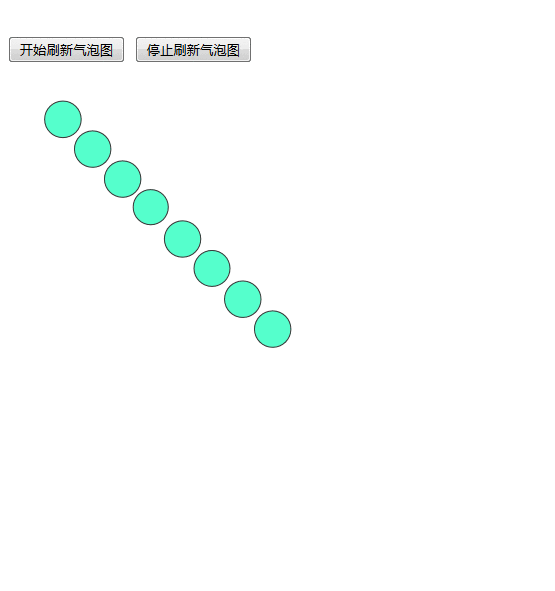AngularJS2 与 D3.js集成实现自定义可视化的方法
发布于 2018-03-16 21:56:38 | 237 次阅读 | 评论: 0 | 来源: 网友投递
这里有新鲜出炉的AngularJS Tutorial中文版,程序狗速度看过来!
AngularJS 前端JS框架
AngularJS诞生于Google是一款优秀的前端JS框架,已经被用于Google的多款产品当中。AngularJS有着诸多特性,最为核心的是:MVC、模块化、自动化双向数据绑定、语义化标签、依赖注入,等等。
本篇文章主要介绍了ANGULAR2 与 D3.js集成实现自定义可视化的方法,小编觉得挺不错的,现在分享给大家,也给大家做个参考。一起跟随小编过来看看吧
本文介绍了ANGULAR2 与 D3.js集成实现自定义可视化的方法,分享给大家,具体如下:
目标
- 展现层与逻辑层分离
- 数据与可视化组件相分离
- 数据与视图双向绑定,实时更新
- 代码结构清晰,易于维护与修改
基本原理
angular2 的组件生命周期钩子方法\父子组件交互机制\模板语法
源码解析
代码结构很简单,其中除主页index.html和main.ts之外的代码结构如下所示:

代码结构
app.module.ts
import { BrowserModule } from '@angular/platform-browser';
import { NgModule } from '@angular/core';
import { FormsModule } from '@angular/forms';
//components
import { AppComponent } from './app.component';
import { Bubbles } from './bubbles.component';
@NgModule({
declarations: [
AppComponent,
Bubbles
],
imports: [
BrowserModule,
FormsModule
],
providers: [],
bootstrap: [AppComponent]
})
export class AppModule { }
app.component.html
实现宿主视图定义,
2个按钮,按钮可以绑定了2点点击事件,执行相应的动作,刷新数组,同时完成汽泡图的更新;
1个汽泡图子组件,其中values为子组件的输入属性,实现父子组件之间的通信,numArray为汽泡图的输入数据数组,后续为随机生成的数组
<h1>
<button (click)="refreshArr()" >开始刷新气泡图</button>
<button (click)="stopRefresh()" >停止刷新气泡图</button>
<bubbles [values]="numArray"></bubbles>
</h1>app.component.ts
通过指定一个3秒刷新一次的定时器,刷新数据,这里需要注意,需要先清空数组,再添加元素,直接修改数组元素值而不改变引用,则无法刷新汽泡图
import { Component, OnDestroy, OnInit } from '@angular/core';
@Component({
selector: 'app-root',
templateUrl: './app.component.html',
styleUrls: ['./app.component.css']
})
export class AppComponent implements OnInit, OnDestroy {
intervalId = 0;
numArray = [];
// 清除定时器
private clearTimer() {
console.log('stop refreshing');
clearInterval(this.intervalId);
}
// 生成指定范围内的随机数
private getRandom(begin, end) {
return Math.floor(Math.random() * (end - begin));
}
ngOnInit() {
for (let i in this.numArray) {
this.numArray[i] = this.getRandom(0, 100000000); // "0", "1", "2",
};
}
// 元素关闭清除定时器
ngOnDestroy() { this.clearTimer(); }
// 启动定时刷新数组
refreshArr() {
this.clearTimer()
this.intervalId = window.setInterval(() => {
this.numArray = [];
for (let i=0;i<8;i++)
{
this.numArray.push(this.getRandom(0, 100000000));
}
}, 3000);
}
// 停止定时刷新数组
stopRefresh() {
this.clearTimer();
}
}
bubbles.component.ts 汽泡图组件类
- ngOnChanges() 生命周期方法,可以在输入属性values发生变化时,自动被调用;
- @ViewChild 可以获取对子元素svg的引用,其中#target自定义变量用于标识svg子元素
import { Component, Input, OnChanges, AfterViewInit, ViewChild} from '@angular/core';
import {BubblesChart} from './bubbles.chart';
declare var d3;
@Component({
selector: 'bubbles',
template: '<svg #target width="900" height="300"></svg>',
})
export class Bubbles implements OnChanges, AfterViewInit {
@Input() values: number[];
chart: BubblesChart;
@ViewChild('target') target;//获得子组件的引用
constructor() {
}
// 每当元素对象上绑定的数据 输入属性值 values 发生变化时,执行下列函数,实现图表动态变化
ngOnChanges(changes) {
if (this.chart) {
// 先清空汽泡图,再重新调用汽泡图对象的render方法,根据变动后的值绘制图形
this.chart.destroy();
this.chart.render(changes.values.currentValue);
}
}
ngAfterViewInit() {
// 初始化汽泡图
this.chart = new BubblesChart(this.target.nativeElement);
this.chart.render(this.values);
}
}
bubbles.chart.ts 汽泡图类
- d3.js 语法定义的汽泡图类,自带一个绘制方法和擦除方法
- 需要在index.html当中先引入 <script src="//d3js.org/d3.v2.js"></script>
declare var d3;
// define a bubble chart class
// Exports the visualization module
export class BubblesChart {
target: HTMLElement;
//构造函数, 基于一个 HTML元素对象内部来绘制
constructor(target: HTMLElement) {
this.target = target;
}
// 渲染 入参为数值 完成基于一个数组的 汽泡图的绘制
render(values: number[]) {
console.log('start rendering');
console.log(values);
d3.select(this.target)
// Get the old circles
.selectAll('circle')
.data(values)
.enter()
// For each new data point, append a circle to the target SVG
.append('circle')
// Apply several style attributes to the circle
.attr('r', d => Math.log(d)) // 半径
.attr('fill', '#5fc') // 颜色
.attr('stroke', '#333') // 轮廓颜色
.attr('transform', (d, i) => { // 移动位置
var offset = i * 30 + 3 * Math.log(d);
return `translate(${offset}, ${offset})`;
});
}
destroy() {
d3.select(this.target).selectAll('circle').remove();
}
}
效果展示

以上就是本文的全部内容,希望对大家的学习有所帮助,也希望大家多多支持phperz。
推荐阅读
最新资讯